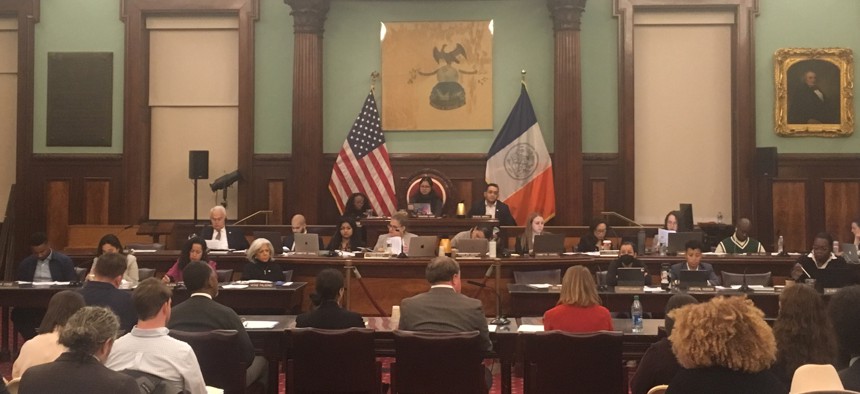New York City
City Council members balk at $4.5 million in cuts to supportive housing rental subsidies
The Adams administration defended the proposed reduction as “right-sizing.”

A New York City Council oversight hearing on housing for homeless New Yorkers on Thursday at City Hall Ethan Geringer-Sameth
Adams administration officials defended a proposed $4.5 million reduction in rental subsidies for supportive housing residents as “right-sizing” on Thursday during a City Council oversight hearing on housing for homeless New Yorkers.
Citing sizable vacancies in the city’s limited stock of supportive housing despite a long waitlist to get in, members of the City Council raised alarms at the budget cut – one of a slate of reductions as part of Mayor Eric Adams’ “Program to Eliminate the Gap,” announced in his November financial plan. Supportive housing is a subset of affordable housing for people experiencing or at risk of chronic homelessness, which comes with on-site social services and case management.
“We know supportive housing is one of the most effective methods that the city has to curb homelessness and yet while the demand for supportive housing continues to increase we understand that there are thousands of units sitting vacant,” said Council Member Diana Ayala, chair of the Committee on General Welfare, who co-chaired the hearing with the Committees on Veterans, Housing and Buildings, and Mental Health, Disabilities and Addiction.
“We also know that there are many barriers to entry into supportive housing, particularly for those from the most marginalized populations,” she said.
According to Michael Bosket, executive deputy commissioner of the city’s Human Resources Administration, approximately 2,000 units of supportive housing are currently vacant, with 94% of the city’s roughly 33,000 units occupied with a permanent resident. While the city has improved the time it takes to make a referral to supportive housing – down to 54 days in the current fiscal year, compared with 100 days the year before – there are still five people waiting for housing for each person placed in a unit, Bosket said. The city receives 800 applications for supportive housing every month.
“Can you explain to us why, when we have a need for supportive housing across the city of New York, we are seeking a cost savings in rental support” for supportive housing, asked Council Member Pierina Sanchez, chair of the housing committee.
“We have to project out a couple of years when we think units will come online and be open and ready for occupancy and what the distribution of those units will be,” said Emily Lehman, assistant commissioner for special needs housing at the Department of Housing Preservation and Development. “And so the PEG we have in the benefit plan for the 15/15 rental assistance is really just a right-sizing of when those units actually did come online.”
According to Bosket, 600 of the 2,000 vacant units have been assigned to an individual or family who has yet to move in. Many of the remaining 1,400 units are in need of repair to be made livable, with 9,000 units part of the city’s original decades-old supportive housing stock. In other cases, applicants may have rejected the lodgings, he said.
“Clients have a right, clients have a choice, that’s very important to us,” Bosket said. “So even with the units that are left that are vacant, does not mean people haven’t been referred to those units.”
Bosket could not say how many supportive housing applicants had received a referral for placement.
